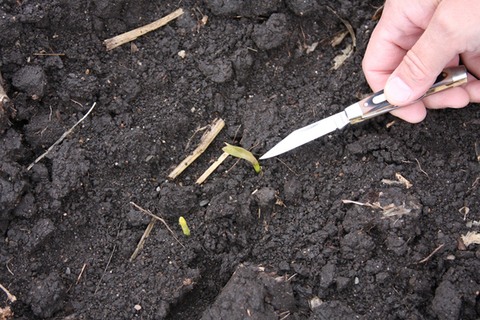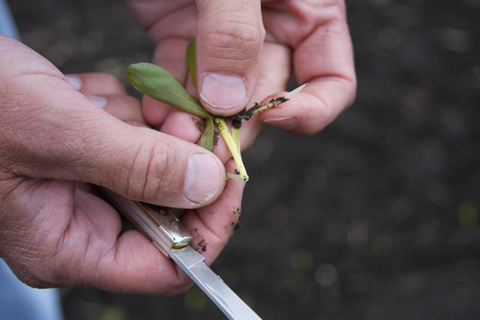Early corn emergence dates increase the risk of spring freeze damage, especially in low-lying areas in Minnesota.
View dates of the last spring freze for numerous Minnesota locations (compiled by the Minnesota Climatology Working Group).
Areas susceptible to freeze damage
Freeze damage can occur when air temperatures are in the mid-30s on calm nights, as the lack of wind allows heat to transfer from air near the ground to the air above. This results in colder temperatures near the soil surface.
Settings where freeze damage is generally worse include:
Low areas where cold, dense air settles.
Near field edges, as vegetation makes it harder for heat to transfer from the soil to the air above.
Fields with high levels of surface residue coverage, as this limits heat transfer from the soil.
Recently row-cultivated fields. These fields are more susceptible to freeze injury because tillage dries the surface soil, reducing the amount of heat and moisture that can be transferred from the soil to the air.
Peat or sandy soils, as these lose heat more quickly.
Assessing freeze injury
Carefully evaluate fields to determine if the freeze-damaged corn will survive.
What to look for
Symptoms of freeze-damaged corn are initially discolored and water-soaked leaves, which later dry and turn brown. Because the corn plant’s growing point remains below the soil until the fifth to sixth leaf-collar stage, freezing temperatures before this stage does not typically kill the plant unless the upper part of the soil – where the growing point is located – freezes.
Corn plants with growing points not damaged by the freeze generally show new leaf growth after a few days. So, delay assessing freeze-damaged fields until three to five days after the freezing temperatures.
Larger freeze-damaged corn plants can resemble buggy whips, as new vegetative growth tries to break free of dead tissue. Buggy-whipped plants generally recover. This happens at a faster recovery rate for smaller plants and when warm and windy conditions follow the freeze.
Whether plants will survive
To determine whether freeze-damaged corn will survive, dig up plants and split stems to examine the growing point and the tissue directly above the growing point. Healthy growing points will be firm and white to yellow.
If the growing point or tissue within 0.5 inches above the growing point is damaged, it will be water-soaked and orange to brown. In this case, recovery is unlikely.
Corn recovery is greatest when the freeze occurs before the three leaf-collar stage (V3) or, if after the three leaf-collar stage, when it damages only a limited amount of leaf area. This is because the amount of energy reserves in the seed and leaf area for growth partially influences recovery.
It’s best to let freeze-damaged plants recover on their own. Removing the dead tissue by mechanical means or spraying health-inducing compounds will not improve the crop’s survivability and could make things worse.
Yield reductions due to freeze damage
Whether or not freezing temperatures will impact yield depends on stand loss, the severity of plant damage and recovery-slowing issues such as pathogens.
Minnesota growers can expect yield losses of 5, 12 and 24 percent when the final plant population reduces to 28,000, 22,000 and 16,000 plants per acre, respectively.
Research from the University of Wisconsin found that cutting off all corn plants at the soil surface during the second leaf-collar stage reduced yield by 8 percent, but that cutting off only half the plants resulted in minimal yield reduction.
In addition to yield losses, freeze-damaged plants may reach maturity a few days later than normal.
Replanting considerations
Before replanting, consider the existing crop’s yield potential, replanting costs and the replanted crop’s yield potential. Replant costs including time, fuel, seed costs and penalties related to hybrid selection if the best genetics are no longer available.
In addition, consider the length of the remaining growing season and select hybrids of appropriate maturity.
Growing degree days available for various Minnesota planting dates
Weigh yield potential from reduced stands against potential yield reductions from later planting dates. For example, if the date is May 20, it would pay off to replant only if the populations were less than 26,000 - 28,000 plants per acre (Tables 1 and 2).
As shown in Table 1, planting date influences the yield potential of a replanted crop. In Minnesota, corn planted from May 20 to 25 yields about 87 to 95 percent of the corn planted in late April to early May.
Table 1: How planting date affects corn yield, as a percent of maximum
| Planting date | Percent of maximum grain yield | Percent of maximum grain yield |
|---|---|---|
| Study 1: Lamberton (1988-2003)* | Study 2: Lamberton, Morris and Waseca (2009-2011) | |
| 20-Apr | 99% | 98% |
| 25-Apr | 100% | 99% |
| 30-Apr | 100% | 100% |
| 5-May | 99% | 100% |
| 10-May | 98% | 99% |
| 15-May | 95% | 98% |
| 20-May | 92% | 95% |
| 25-May | 87% | 92% |
| 30-May | 82% | 89% |
| 4-Jun | 76% | 84% |
| 9-Jun | 69% | 79% |
Table 2: How corn plant population affects yield potential
| Population (plants per acre) | Grain yield potential |
|---|---|
| 36,000 | 100% |
| 34,000 | 99% |
| 32,000 | 99% |
| 30,000 | 97% |
| 28,000 | 95% |
| 26,000 | 93% |
| 24,000 | 91% |
| 22,000 | 88% |
| 20,000 | 84% |
| 18,000 | 80% |
| 16,000 | 76% |
If you replant
When replanting very thin to non-existent stands, seeding directly into the existing seedbed is a better option than working up mud.
Remove existing plants by the appropriate herbicide or tillage when replanting low, but variable, stands. You may also need tillage for fields hardened by heavy rain or with previous tillage problems.
Finally, remember to adjust the relative maturity (RM) of your hybrid (Table 3).
Table 3: Corn maturity guidelines for late planting in Minnesota
| Planting date | Relative maturity (RM) units earlier than full-season for the region |
|---|---|
| Prior to May 22 | Plant normal seed choices |
| May 22 to 28 | 5 to 7 relative maturity units |
| May 29 to June 4 | 8 to 15 relative maturity units |
| June 5 to 10 | 15 or more relative maturity units |
Carter, P., & Wiersma, D. (2006). Early season frost damage to corn.
Coulter, J. (2010). Plan now for successful corn planting.
Coulter, J. (2018). Optimal plant population for corn in Minnesota.
Lauer, J. (2007). Frost impact on corn at early growth stages.
Nielsen, R.L. (2019). Corny growing points of interest.
Nielsen, R.L. (1998). Assessing frost damage to young corn.
Southwest Research and Outreach Center (SWROC). (2010). Available soil water vs. historic average (1966-2009).
Reviewed in 2021



